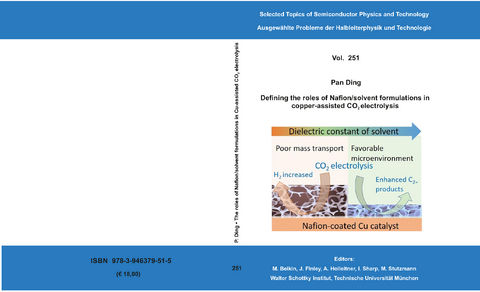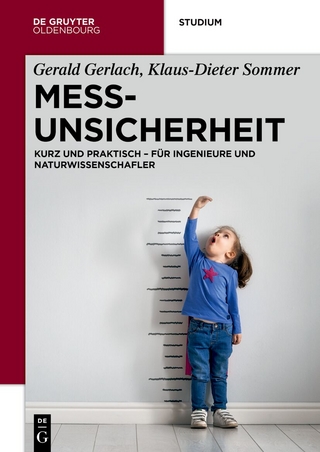Defining the roles of Nafion/solvent formulations in copper-assisted CO2 electrolysis
Seiten
2023
Verein zur Förderung des Walter Schottky Instituts der Technischen Universität München (Verlag)
978-3-946379-51-5 (ISBN)
Verein zur Förderung des Walter Schottky Instituts der Technischen Universität München (Verlag)
978-3-946379-51-5 (ISBN)
- Titel nicht im Sortiment
- Artikel merken
Electrochemical CO2 reduction to value-added chemical feedstocks is of tremendous interest for storing chemical energy from renewable sources while reducing CO2 emissions from human activities. Copper is one of the most effective catalysts for converting carbon dioxide (CO2) into hydrocarbons or oxygenates, although it suffers from low product selectivity and limited long-term durability. To address this, CO2 reduction catalyst layers (CLs) are often prepared from inks containing catalyst nanoparticles and organic binders that can improve stability while also impacting the local reaction environment. In this regard, Nafion ionomer, composed of hydrophobic perfluorocarbon backbones and hydrophilic sulfonic acid side chains, is the most widely used additive for preparing CLs for electrochemical CO2 reduction, but its impact on the performance of CO2 electrolysis remains poorly understood.
Here, we first systematically investigate the role of the catalyst ink formulation on CO2 electrolysis using commercial CuO nanoparticles as the model pre-catalyst and carbon paper as a high surface area support. We find that the presence of Nafion is essential for achieving stable product distributions due to its ability to stabilize the catalyst morphology under reaction conditions. Moreover, the Nafion content and solvent composition (water/alcohol fraction) regulate the internal structure of Nafion films, as well as the catalyst morphology, thereby significantly impacting CO2 electrolysis performance, resulting in variations of C2+ product FE by >3×, with C2+ FE ranging from 17% to 54% on carbon paper substrates. Using a combination of ellipsometry and in situ Raman spectroscopy during CO2 reduction, we find that such selectivity differences stem from changes to the local reaction microenvironment. In particular, the combination high water/alcohol ratios and low Nafion fractions in the catalyst ink result in stable and favorable microenvironments, increasing the local CO2/H2O concentration ratio and promoting high CO surface coverage to facilitate C2+ production in long-term CO2 electrolysis.
Building upon these insights regarding Nafion/solvent formulations, we utilized a systematic methodology to optimize electrochemical CO2 reduction on planar glassy carbon substrates, which represent another widely used substrate for preparing CLs for electrochemical CO2 reduction. We demonstrate that by simply tailoring the Nafion/solvent formulations of catalyst slurries, one can modify the properties of Nafion films on CuO-derived catalysts, thereby enabling the CO2 reduction performance in CO2 electrolysis to be tuned. With the optimal formulation, efficient mass transport and favorable electrochemical fragmentation of catalyst particles can be realized on glassy carbon substrates, which progressively enhances the production of C2+ products with a remarkably high Faradaic efficiency of 87% for over 200 h.
Overall, this work provides insights into the critical role of Nafion binders on optimizing Nafion/solvent formulations as a means of enhancing performance of electrochemical CO2 reduction systems. These findings highlight the importance of engineering Nafion films to enhance electrochemical performance in varied electrochemical applications.
Here, we first systematically investigate the role of the catalyst ink formulation on CO2 electrolysis using commercial CuO nanoparticles as the model pre-catalyst and carbon paper as a high surface area support. We find that the presence of Nafion is essential for achieving stable product distributions due to its ability to stabilize the catalyst morphology under reaction conditions. Moreover, the Nafion content and solvent composition (water/alcohol fraction) regulate the internal structure of Nafion films, as well as the catalyst morphology, thereby significantly impacting CO2 electrolysis performance, resulting in variations of C2+ product FE by >3×, with C2+ FE ranging from 17% to 54% on carbon paper substrates. Using a combination of ellipsometry and in situ Raman spectroscopy during CO2 reduction, we find that such selectivity differences stem from changes to the local reaction microenvironment. In particular, the combination high water/alcohol ratios and low Nafion fractions in the catalyst ink result in stable and favorable microenvironments, increasing the local CO2/H2O concentration ratio and promoting high CO surface coverage to facilitate C2+ production in long-term CO2 electrolysis.
Building upon these insights regarding Nafion/solvent formulations, we utilized a systematic methodology to optimize electrochemical CO2 reduction on planar glassy carbon substrates, which represent another widely used substrate for preparing CLs for electrochemical CO2 reduction. We demonstrate that by simply tailoring the Nafion/solvent formulations of catalyst slurries, one can modify the properties of Nafion films on CuO-derived catalysts, thereby enabling the CO2 reduction performance in CO2 electrolysis to be tuned. With the optimal formulation, efficient mass transport and favorable electrochemical fragmentation of catalyst particles can be realized on glassy carbon substrates, which progressively enhances the production of C2+ products with a remarkably high Faradaic efficiency of 87% for over 200 h.
Overall, this work provides insights into the critical role of Nafion binders on optimizing Nafion/solvent formulations as a means of enhancing performance of electrochemical CO2 reduction systems. These findings highlight the importance of engineering Nafion films to enhance electrochemical performance in varied electrochemical applications.
| Erscheinungsdatum | 30.12.2023 |
|---|---|
| Sprache | englisch |
| Maße | 150 x 210 mm |
| Themenwelt | Naturwissenschaften ► Physik / Astronomie |
| Schlagworte | CO2 reduction reaction • Copper • Nafion |
| ISBN-10 | 3-946379-51-6 / 3946379516 |
| ISBN-13 | 978-3-946379-51-5 / 9783946379515 |
| Zustand | Neuware |
| Haben Sie eine Frage zum Produkt? |
Mehr entdecken
aus dem Bereich
aus dem Bereich
von den Werkzeugen über Methoden zum TQM
Buch | Softcover (2024)
Springer Fachmedien (Verlag)
32,99 €
kurz und praktisch - für Ingenieure und Naturwissenschafler
Buch | Softcover (2024)
De Gruyter Oldenbourg (Verlag)
44,95 €




